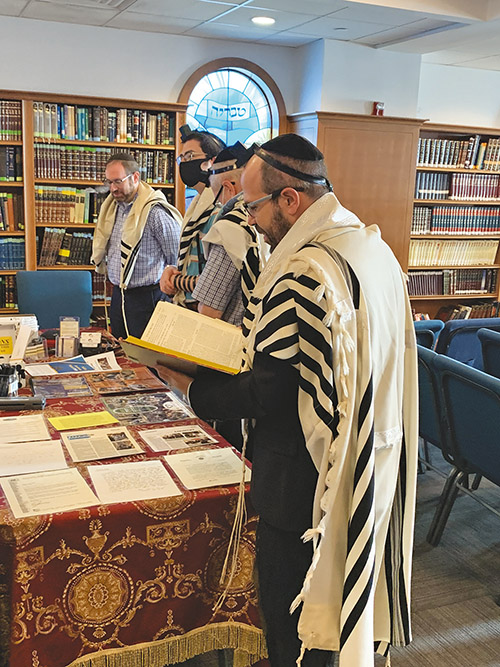
On Sunday morning, October 17, Congregation Beth Aaron of Teaneck, for the second time, hosted the Tefillin Awareness Project/Hanacha K’Halacha (TAP) at its morning minyanim. Over 150 men and boys from the shul and surrounding community availed themselves of this free service through which the individual’s placement of tefillin shel rosh and yad are observed for correct placement and tefillin
are examined for damage and flaws. Most times these flaws are fixed on the spot by experienced sofrim. If more extensive repair is required, recommendations of batim machers and other experts are offered.
On Shabbat afternoon, prior to the TAP event, Rabbi Larry Rothwachs, morah d’atra of Beth Aaron, addressed the congregation about the program. In introducing the importance of this Biblical injunction, which has very specific and detailed requirements, Rabbi Rothwachs referred to an early work of Rav Kook who described the holy mitzvah of tefillin as follows: “It is therefore of paramount importance that we deliberately place the sacred tefillin properly and accurately at the locations of the brain and strength, so that their sanctity will flow from these locations, the head and arm, throughout our physical entity. Such accurate placement, not lower or higher, will prevent the spread of any improper thoughts and actions and will prevent the misuse of our brain and arm-strength in any way that is improper for our holy children of Israel.”
Rabbi Rothwachs thanked the gracious sponsors of the upcoming Beth Aaron program for their generosity in making this TAP visit possible and thus ensuring the proper performance of this fundamental mitzvah. A hearty yasher koach and thank you went to the Hager family for their sponsorship of the TAP in memory of Chaya’s Father, Tzvi Yosef ben ha’Rav Eliezer, whose yahrzeit was on the 7th of Cheshvan.
What motivated Flatbush businessman Avrohom B. Schachter to undertake the enormous project of ensuring the proper placement of tefillin on head and arm during davening? As a frum man davening in halachic minyanim his whole life, what was it that sparked the creation of the Tefillin Awareness Project/Hanacha K’Halacha?
Before TAP, Schachter would approach individuals during Shacharit and help them adjust their tefillin or tefillin knots so that they adhered to the d’oraita requirements. His assistance was always greatly appreciated. But at a vacation to a community of retirees he witnessed the sad and staggering phenomenon that at least 50% of the veteran daveners were misplacing their tefillin on head and hand. If knowledgeable men who had been placing tefillin every day for many years were in need of correction with this fundamental mitzvah that was performed a minimum of 300 days per year, then surely younger daveners would need assistance. So in March of 2007, together with Rabbi Eli Teitelbaum, z”l, and a few others, Schachter arranged a gathering through Brooklyn Agudah to which 300 attended and many availed themselves of the free service being offered.
Encouraged by this first foray into the community, Schachter decided to create a program that he would bring to the wider public. His first step was to contact the Vaad L’Mishmeres Stam, which connected him with a group of sofrim who would accompany him on his visits to shuls, schools and batei midrash through the U.S. During his busy work week he devoted many hours to arranging visits to shuls and schools in various communities on Sunday mornings to address as many minyanim as possible in one visit. From Toronto to Teaneck, from Lakewood to Long Island, and even to small communities such as Bensalem Outreach Center in Bensalem, Pennsylvania, Schachter and his team have addressed rabbanim, roshei yeshiva and baalei batim of all ages on the proper halachot of tefillin.
The program, which Schachter introduced briefly before the inspections begin, focuses on the placement of the yad and its kesher, the placement of the rosh and its kesher, the blackness of the retzuot (straps), the width of the retzuot, the position of the tefirot (stitches), and the rebu’ah of batim (squareness of the boxes) and prudot (separations of layers). There is no charge for the external examination of the tefillin. Touch-ups on cracked or fading retzuot are offered free of charge. New retzuot are available for purchase and are attached by the sofrim at the sitting.
Now entering its 14th year, it is estimated that TAP has serviced well over 50,000 pairs of tefillin in over 700 venues. The program addresses both Sephardic and Ashkenazic minyanim, multiple minyanim in one facility, with up to 12 sofrim available, and may last as long as six hours at one large venue. Programs have been held in the Midwest including Cincinnati, and other communities have requested visits from the program.
As TAP’s services are free to its recipients, where is the funding that makes it all possible coming from? At the various venues, sponsoring individuals come forward and either fully or partially underwrite the program, which primarily includes paying the sofrim and batim makers for their travel and hands-on work. “Some programs require as many as 12 sofrim and last six hours, which can add up to a cost of $2,000 or more. One way or another, Hashem makes it work,” attested Schachter. Very often Schachter himself subsidizes any gaps in payment and does so graciously l’shem shamayim.
When asked how he has the stamina to keep up this grueling weekly program and all of its complicated preparations while running a business full-time, Schachter replied, “But how can I not continue this holy work after I see how many of our acheinu bnei Yisrael need this service desperately, and that it runs the entire gamut of klal Yisrael.”
To contact the Tefillin Awareness Project email [email protected]. For tax deductible donations, write your check to V’Ani Tefilla Foundation and mail to Mr. Schachter, 1114 East 24 Street, Brooklyn, NY 11210.
By Pearl Markovitz













